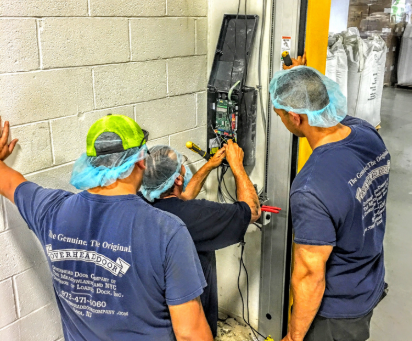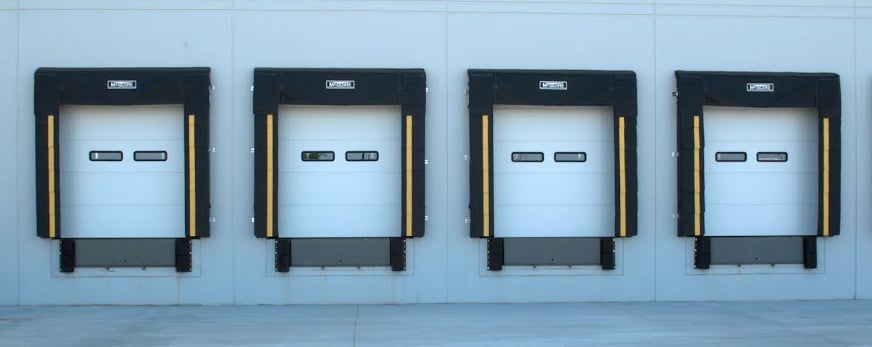The loading dock is the bustling heart of any commercial or industrial operation. It's where raw materials arrive, finished products depart, and the efficiency of your supply chain is truly put to the test. Yet, beneath this constant activity lies a hidden danger that can compromise warehouse safety, halt operations, and incur significant costs: trailer creep.
At Loading Dock Inc., we understand that a truly optimized loading dock is one where safety and efficiency work hand-in-hand. This is why vehicle restraints are not just another piece of loading dock equipment; they are indispensable guardians against the unpredictable, ensuring that your dock operates at peak performance while protecting your most valuable assets: your people and your products.
 Vehicle Restraints Are Essential For Preventing Accidents
Vehicle Restraints Are Essential For Preventing Accidents
The Silent Danger: Understanding Trailer Creep and Its Risks
Imagine a forklift moving rapidly into a trailer during loading or unloading. Now, imagine that trailer, slowly but surely, inching away from the dock face. This subtle, unintentional movement is known as trailer creep. It can happen for a variety of reasons, from the impact of heavy forklifts entering and exiting, to the natural suspension movement of air-ride trailers, or even insufficient traditional wheel chocks.
 Wheel Chocks Are Sometimes An Insufficient Safety Measure In Busy Loading Dock Areas
Wheel Chocks Are Sometimes An Insufficient Safety Measure In Busy Loading Dock Areas
The consequences of trailer separation or premature trailer departure are catastrophic. The gap created, even if just a few inches, can cause a forklift to drop, resulting in:
● Severe Worker Injury or Fatality: Forklift operators and other dock personnel are at extreme risk of being crushed, falling, or suffering impact injuries. This is a leading cause of serious loading dock accidents.
● Catastrophic Product Damage: Valuable inventory can be ruined as it tumbles from a falling forklift or an unaligned dock.
● Expensive Equipment Damage: Forklifts, dock levelers, and even the trailer itself can sustain significant damage, leading to costly repairs and replacements.
● Operational Downtime: Every accident means a halt in operations, investigations, repairs, and potential legal repercussions, all of which translate directly to lost revenue and productivity.
● Legal Liability and OSHA Compliance Issues: Failure to provide a safe working environment can lead to hefty fines, legal battles, and a damaged reputation. Adhering to OSHA loading dock safety guidelines, which increasingly emphasize secure vehicle positioning, is paramount.
While traditional wheel chocks have their place, they often rely on human consistency and can be ineffective against strong forces, tire slippage, or deliberate (but unauthorized) trailer movement. This is where the advanced engineering of vehicle restraint systems becomes critical.
The Unsung Hero: What Are Vehicle Restraints?
Vehicle restraints are electromechanical or hydraulic devices designed to securely engage a truck or trailer to the loading dock structure. Unlike simple chocks, they create a formidable barrier that prevents unintended movement, making the dock-to-trailer connection as stable as possible. They are a cornerstone of modern warehouse safety solutions.
There are two primary categories of these essential dock locks:
➜ Rear Impact Guard (RIG) Restraints: These systems typically use a large, rotating hook or a barrier arm that engages directly with the rear impact guard (RIG) or ICC bar of the trailer. Once engaged, the trailer is physically locked to the building, virtually eliminating trailer creep and premature departure.
%20Type-418585-edited-718838-edited-037015-edited.png?width=400&height=170&name=Vehicle%20Restraints%20101%3B%20Rear%20Impact%20Guard%20(RIG)%20Type-418585-edited-718838-edited-037015-edited.png) Rear Impact Guard (RIG) Restraints
Rear Impact Guard (RIG) Restraints
➜ Wheel-Based Restraints: These systems typically use a barrier arm that rises in front of one of the rear wheels, holding the trailer securely in place. They are effective for trailers that may not have a standard RIG or for specific operational needs.
Both types are designed to be robust, often featuring interlocks with the dock leveler and integrated communication systems (like exterior red/green lights and interior alarms) to provide clear signals to both truck drivers and dock personnel, ensuring synchronized and safe operations.
Boosting Safety: The Primary Benefit of Vehicle Restraints
The most compelling argument for investing in vehicle restraints is the unparalleled enhancement they bring to loading dock safety. They are proactive solutions that mitigate risk before accidents can occur.
✔ Absolute Prevention of Premature Departure: This is their defining safety feature. Once engaged, a trailer cannot pull away from the dock until the restraint is intentionally disengaged by authorized personnel. This eliminates "drive-aways" and "creep-aways," which are among the most dangerous scenarios on a loading dock
.
✔ Eliminating the Gap: By keeping the trailer firmly against the dock, vehicle restraints prevent the hazardous gap that can form due to trailer creep. This ensures a continuous, stable surface for forklifts and foot traffic, drastically reducing the risk of forklifts falling or workers tripping.
✔ Enhanced Forklift Safety: Forklifts are heavy machinery, and even a slight misalignment can lead to a tip-over or a fall off the edge of the dock. Securely held trailers mean forklift operators can work with greater confidence and less risk, protecting both the equipment and the operator.
✔ Protecting Dock Personnel: Beyond forklift drivers, other workers on the dock are vulnerable. Vehicle restraints ensure that the trailer remains stable while they are performing tasks, minimizing the risk of being caught between a moving trailer and the dock or wall.
✔ Minimizing Product and Equipment Damage: A stable trailer platform means fewer jolts, bumps, and unexpected movements that can lead to product spills, damaged goods, or stress on the loading dock equipment itself, including the dock leveler.
✔ Ensuring OSHA Compliance and Reducing Liability: OSHA compliance mandates that trailers be adequately secured during loading and unloading. Modern truck restraint systems provide a verifiable, consistent method of compliance that reduces the risk of fines and legal challenges. By proactively addressing safety, your company also reduces its overall liability and can often benefit from lower insurance premiums.
✔ Integrated Communication for Flawless Operation: Most modern vehicle restraint systems are equipped with advanced dock communication systems. These typically include exterior traffic lights (red for stop, green for proceed) for the truck driver and corresponding interior lights and audible alarms for dock personnel. This clear, unambiguous signaling system prevents miscommunication, ensuring that everyone is aware of the trailer's status (secured or released) and promoting synchronized, safe procedures.
 Image Shows Safety Measures For Loading Docks
Image Shows Safety Measures For Loading Docks
Enhancing Efficiency: How Restraints Optimize Operations
While safety is paramount, vehicle restraints are also powerful tools for boosting loading dock productivity and overall operational efficiency.
◆ Increased Confidence and Speed: When dock workers and forklift operators know the trailer is absolutely secure, they work more confidently and, consequently, more quickly. The mental burden of worrying about trailer movement is removed, allowing them to focus solely on the task at hand.
◆ Smoother and Faster Loading/Unloading Cycles: The elimination of trailer creep means no time is wasted repositioning the trailer or stopping operations for safety checks. Each loading and unloading cycle is streamlined, leading to faster turnaround times for trucks and increased throughput for your warehouse. This is critical for logistics optimization.
◆ Reduced Downtime from Accidents: Every incident on the loading dock, no matter how minor, can lead to costly downtime. Accidents require investigations, cleanup, equipment repairs, and potentially medical attention. By preventing these incidents, vehicle restraints ensure continuous operation, keeping your supply chain flowing without interruption.
◆ Streamlined Logistics and Flow: A dock equipped with reliable restraints contributes to a more predictable and efficient flow of goods. This translates to better scheduling, fewer bottlenecks, and a more organized overall logistics operation, which is vital for any business focused on supply chain improvements.
◆ Protecting Energy Efficiency Measures: When a trailer is securely restrained, dock seals and dock shelters can maintain their tight seal against the trailer more effectively. This reduces the infiltration of outside air, maintaining interior temperatures and contributing to your facility's overall energy efficiency.
 Vehicle Restraints: Powerful Tools
Vehicle Restraints: Powerful Tools
Choosing the Right Vehicle Restraint for Your Loading Dock
Selecting the ideal vehicle restraint for your facility involves more than just picking a model. It requires a thorough assessment of your specific operational needs, trailer types, and existing dock infrastructure.
Considerations include:
⁃ Trailer Compatibility: Do you handle a wide variety of trailer types (e.g., standard, pup, refrigerated, those with hydraulic lift gates)? Some restraints are more versatile than others.
⁃ Frequency of Use: High-volume docks may benefit from fully automatic, high-speed restraints, while lower-volume docks might opt for more economical, manual systems.
⁃ Dock Configuration: Factors like dock height, approach grade, and available space influence the best restraint type.
⁃ Budget: While cost is a factor, remember that the investment in safety and efficiency quickly provides a substantial return on investment (ROI).
⁃ Integration Needs: How well will the restraint system integrate with your existing dock levelers and safety protocols?
A professional assessment from a knowledgeable loading dock equipment supplier, such as Loading Dock, Inc., is essential to ensure you select the optimal loading dock solution that meets your unique requirements.
The Loading Dock Inc. Advantage: Why Partner With Us
At Loading Dock Inc., we are more than just a supplier of commercial overhead doors and loading dock equipment. We are your partners in optimizing your facility for maximum safety and efficiency. Our team of experts brings unparalleled knowledge and experience in:
• Comprehensive Dock Assessments: We analyze your current operations to recommend the most effective vehicle restraint systems and other loading dock safety solutions.
• High-Quality Products: We offer a wide range of truck restraint systems from leading manufacturers, known for their durability and reliability.
• Expert Installation: Our certified technicians ensure flawless loading dock installation, guaranteeing that your equipment operates as intended and meets all safety standards.
• Ongoing Maintenance and Service: We provide routine loading dock maintenance and prompt loading dock repair to keep your equipment running smoothly, extending its lifespan, and preventing unexpected downtime.
We are committed to helping businesses across the region achieve a safer, more efficient, and more productive loading dock environment.
 Loading Dock Inc.: Your Trusted Business Partner
Loading Dock Inc.: Your Trusted Business Partner
Secure Your Success
The loading dock is a critical area, and trailer creep is a real, significant threat. Investing in modern vehicle restraints is not merely a cost; it's a strategic investment in the safety of your personnel, the integrity of your products, and the continuous flow of your operations. By stopping trailer creep cold, you unlock peak performance, enhance your overall warehouse efficiency, and solidify your commitment to a secure and productive workplace.
Ready to enhance your loading dock safety and efficiency? Contact Loading Dock, Inc. today for a comprehensive safety assessment and to explore the ideal loading dock solutions for your business.
Call: 973-471-4060
Email: info@loadingdock.com
.png?width=127&height=90&name=LDI%20Logo%202025%20for%20website%20header%203%20(1).png)





